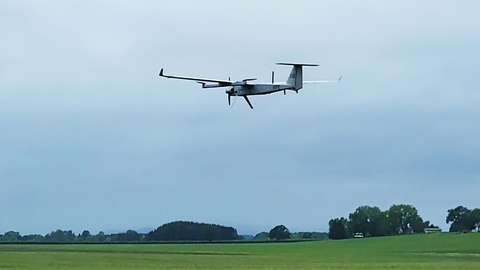AV Successfully Flight Tests JUMP 20 VTOL UAS with a Heavy Fuel Engine
AeroVironment (AV) has successfully tested its JUMP 20 uncrewed aircraft system (UAS) with a heavy fuel engine. This upgrade enhances performance, fuel efficiency, and operational lifespan. The JUMP 20, a VTOL UAS, now offers 13+ hours of endurance and a range of 185 km, running on multiple fuels. The new engine requires less maintenance and features auto-start capability. Shane Hastings, VP and GM of Medium UAS, highlighted the system's suitability for land and sea domains, meeting heavy fuel compatibility requirements. AV plans to continue optimizing the JUMP 20 for extreme conditions.
- AV successfully tested the JUMP 20 UAS with a heavy fuel engine.
- The new engine provides higher horsepower and lower fuel consumption.
- The JUMP 20 now offers 13+ hours of endurance and a 185 km operational range.
- The engine runs on multiple fuels, enhancing flexibility.
- Reduced maintenance cycles and overhauls are required.
- The heavy fuel engine is lighter and includes an auto-start capability.
- The system is suitable for extreme environmental conditions.
- Continued optimization of JUMP 20 for heavy fuel capabilities is planned.
- No immediate financial metrics or revenue impact from the upgrade was disclosed.
- The press release does not specify any new contracts or sales resulting from the successful tests.
Insights
The successful flight test of the JUMP 20 with a heavy fuel engine signifies a substantial enhancement in the UAS (Uncrewed Aircraft System) capabilities, specifically in terms of endurance and operational efficiency. The main advantage of a heavy fuel engine lies in its higher energy density compared to traditional fuels. This translates to longer flight durations and reduced need for refueling, which is critical for both military and commercial applications where operational range and duration are vital.
The ability to operate with multiple fuel types, including heavy fuel, makes the JUMP 20 more versatile and adaptable to varied logistical scenarios. This is particularly beneficial in military operations where fuel availability is often dictated by supply chain constraints. Furthermore, the auto-start capability simplifies operations, reducing the need for extensive operator training and potential human error.
From a technical standpoint, integrating a high endurance, minimal fuel burn engine into a VTOL aircraft substantially reduces the frequency of maintenance cycles and overhauls. This, in turn, lowers the overall operational costs and improves the lifecycle performance of the UAS, making it an economically prudent choice for long-term deployments.
This development is particularly noteworthy within the aerospace and defense markets. The aerospace industry has been moving towards more efficient and sustainable solutions. A VTOL UAS with a heavy fuel engine aligns perfectly with this trend, offering increased operational longevity and improved fuel efficiency. These attributes are keenly sought after by military and defense sectors globally, where endurance and reliability can significantly influence operational success.
The fact that the JUMP 20 can operate on multiple fuel types is a considerable competitive edge. It renders the system more adaptable to various regions and missions, broadening its potential market. This increased adaptability could lead to more significant commercial and governmental contracts, positively impacting AV's revenue streams.
Moreover, the shift towards using heavy fuel engines could position AV as a leader in the UAS market, setting a new standard for operational efficiency and reliability. This enhancement could also attract new investors looking for companies that innovate and push the boundaries within their sectors. Given the ongoing emphasis on multi-domain operations in modern warfare, the JUMP 20 with its advanced fuel capabilities is poised to capture significant market share.
Heavy fuel engine provides JUMP 20 with greater performance, efficient fuel consumption and longer operational lifespan

AV successfully demonstrated a heavy fuel engine-powered JUMP 20 uncrewed aircraft system (Photo: AeroVironment)
“The addition of a heavy fuel engine to the JUMP 20 provides global forces an unparalleled VTOL solution with a longer operational lifespan, greater performance and efficient fuel consumption. It is well suited for land and sea domains where available fuel sources could be dictated by the respective logistics support plan,” said Shane Hastings, AV’s vice president and general manager of Medium UAS. “Heavy fuel compatibility continues to be a strong requirement for many customers, and we’ve made great strides in making our proven JUMP 20 fully compliant with these requirements.”
AV’s JUMP 20 is a vertical take-off and landing (VTOL), fixed-wing UAS with 13+ hours of endurance and an operational range of 185 km (115 mi). The engine is purpose-built for uncrewed systems and capable of running on multiple fuels and gasoline. With over 15 hp output, the high endurance, minimal fuel burn engine also requires less frequent maintenance cycles and overhauls. It is lighter than traditional gasoline engines and has an auto-start capability that delivers customers a simplified UAS requiring less operator engagement to operate and sustain.
“With successful test flights under our belt, AV is excited to continue system testing and further optimizing JUMP 20 with heavy fuel capabilities. This milestone further demonstrates AV’s ability to deliver highly mature and reliable systems capable of working in the most extreme environmental conditions,” continued Hastings.
ABOUT AEROVIRONMENT
AeroVironment (NASDAQ: AVAV) is a global leader in intelligent multi-domain robotic systems, uncrewed aircraft and ground systems, sensors, software analytics and connectivity. Headquartered in
SAFE HARBOR STATEMENT
Certain statements in this press release may constitute "forward-looking statements" as that term is defined in the Private Securities Litigation Reform Act of 1995. These statements are made on the basis of current expectations, forecasts and assumptions that involve risks and uncertainties, including, but not limited to, economic, competitive, governmental and technological factors outside of our control, that may cause our business, strategy or actual results to differ materially from those expressed or implied. Factors that could cause actual results to differ materially from the forward-looking statements include, but are not limited to, our ability to perform under existing contracts and obtain additional contracts; changes in the regulatory environment; the activities of competitors; failure of the markets in which we operate to grow; failure to expand into new markets; failure to develop new products or integrate new technology with current products; and general economic and business conditions in
View source version on businesswire.com: https://www.businesswire.com/news/home/20240618747057/en/
Ashley Riser
AeroVironment, Inc.
+1 (805) 750-6176
pr@avinc.com
Source: AeroVironment, Inc.
FAQ
What improvements were made to AV's JUMP 20 UAS?
How long can the JUMP 20 UAS operate with the new engine?
What fuels can the JUMP 20 UAS run on with the new engine?
What are the benefits of the heavy fuel engine in the JUMP 20 UAS?







